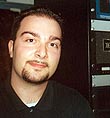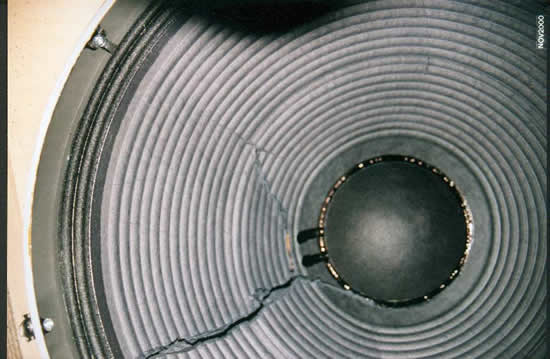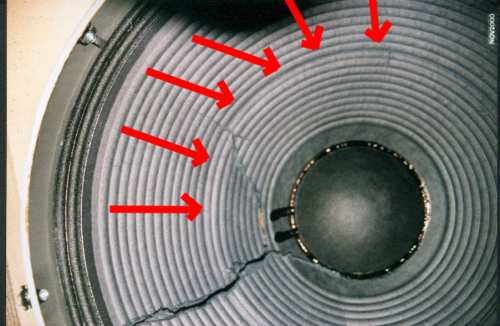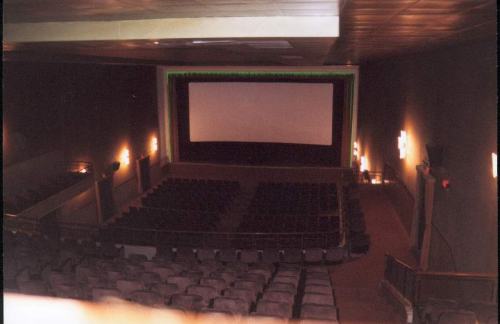|
|
This topic comprises 4 pages: 1 2 3 4
|
|
Author
|
Topic: JBL subwoofer blown
|
Antonio Marcheselli
Phenomenal Film Handler

Posts: 1260
From: Florence, Italy
Registered: Mar 2000
|
 posted 04-12-2001 07:17 AM
posted 04-12-2001 07:17 AM





Hello everyone.
On nov. 99 we had a re-eq by TRUE techs.
The sound in my theater has improved dramatically!!
The problem was the subwoofer: one JBL 4688 powered by a Crown MT 2401 bridged.
Our tech said immediately that that subwoofer is inadequate for the room (600 seats with balcuny).
However he set it to its properly SPL.
The subwoofer last just ONE day (with "american PIE" that has almost NO sub channel!), at the end of the show I heard a strange sound coming from the subwoofer and the woofer coil (hope that "coil" is the right name!) had gone.
The very strange thing is that 4688 has both woofer bridge together and the other woofer was INTACT!
However we had our woofer repaired (from JBL italy). I have my Subwoofer working again with "Les rivieres purpose" (franch film, with a LOT of subwoofer action!!).
The sub channel was wonderful! This convinced me about the quality of our equalization. Ok, only one subwoofer in a theater like mine is not going to shake your dresses but I can assure you that was almost perfect.
Next day I had the feel that the subwoofer was not powerful like previous day.
At night I've discoveded this:  Very bad, isn't it? Pls note that near the center of the woofer there is a "ring" different from the others: I think that that woofer is flyed out...  The very very strange thing is that THE OTHER WOOFER IS INTACT!!!! And, of course, is physically connected to the one in the photo.
Perhaps JBL has put a woofer with a different impedance (I know that that woofers can be found at 8 or 4 Ohms)?? Bye
Antonio
| IP: Logged
|
|
|
|
|
|
Steve Guttag
We forgot the crackers Gromit!!!

Posts: 12814
From: Annapolis, MD
Registered: Dec 1999
|
 posted 04-12-2001 10:18 PM
posted 04-12-2001 10:18 PM




First off, how many subwoofers are needed to play a film at it's reference level (just like all of the other speakers in the sound system) depend on two factors...what the efficientcy of the speaker is (rated in decibels/watt at 1 meter). And the other is how big the room is. In particular, how deep the room is since. You are trying to move air and how much air the sub can move and how much it has to move are the factors.The JBL 4688 is a TCB (triple chamber Bass) subwoofer and it isn't as efficient as other units of similar size and power handing. As such, it isn't surprising that where one might need two 4688s whereas only one of a different subwoofer may be sufficient. At my office, I have the specicfications on the JBL 4688 (and it's internal drivers) and will try to give you more information on the unit. One piece of information I will need is the length of your auditorium in feet or meters. Next to your driver. you are correct in that if the driver fails in multiple driver system from overexcursion, then the other driver(s) also typically have similar damage. If the driver is driven to the point where the voice coil is bottomed out (hits the bottom of the magnet structure) or jumps out of the gap, the other drivers should be doing the same thing, further more, once the first driver fails (and typically opens), the remaining driver(s) will now take ALL of the signal. All of the above presumes the failure mode was from being overdriven not for other types of abuse. From your picture, the cone is cut and that doesn't happen from being over driven. That is a physical damage. It was either cut, rotted, or was defective in manufacture (JBL carries a 5-year warranty on defects, at least in the United States). I would need to see the cone in person to really make a determination on the cause of damage though. I am an JBL, Altec and EV trained/certified warranty repair technician for their speaker products. Steve ------------------
"Old projectionists never die, they just changeover!"
| IP: Logged
|
|
Antonio Marcheselli
Phenomenal Film Handler

Posts: 1260
From: Florence, Italy
Registered: Mar 2000
|
 posted 04-13-2001 08:27 AM
posted 04-13-2001 08:27 AM





Steve,
Look at this:  Pls note the orange arrows. It is clear that the cone has travel out of the gap.
If I push from bottom the cone with my hands, the cone will deformed at the ring when evidenced by arrows. My theater is about 15 meters wide, 30 meters long (stall) and about 45 meters on balcony. It is about 10 meters high. I think that it is about 6000 mq.  Last question: I've asked JBL italy about repairing that cone for the second time and they are in trouble to found out the model of the cone... Can you help me? Thanks for your help!
Bye
Antonio
| IP: Logged
|
|
Stefan Scholz
Expert Film Handler
Posts: 223
From: Schoenberg, Germany
Registered: Sep 1999
|
 posted 04-13-2001 09:35 AM
posted 04-13-2001 09:35 AM





Around 1992/93, when digital sound was about to b e generally introduced to theatres, graphs have been published widely showing the required electrical power vs. sensitivity (dB SPL/1W/1m) and theatre size. Some also added an extra safety margin of 6dB to prevent damage from film tracks not showing the calculated crest factors for general movie tracks.
The "Subwoofer" in digital applications is intended as a "Low Frequency Effects" channel, not as a "Subwoofer" loudspeaker, driven with all signal content below 80 Hz. Unfortunately some mixing engineers I know, tend to use it as a subwoofer, giving more signal content on that channel than intended.
According to JBL (www.jblpro.com/pub/obsolete/4688.pdf) the features are 28 - 350 Hz, 97 dB (1W/1m), 1200 W RMS Cont. PWR. it could well serve (without margin) a theatre up to 30 ft (10m) long. With some safety margin it would be not even good for a living room, which in practise means for theatrical application you'll need more than a single cabinet with multiple amplifiers.
30 M (90ft) stalls 45M (135 ft) balcony with this type would typically require 6+ cabinets with a power amplifier supply of about 8 kW in total for handling modern movie tracks. I know, that's expensive, but dB is a potency scale.
The trick is, to use loudspeakers with a significantly higher SPL sensitivity. The JBL Bandpass is on the very low end of sensitivity.
So adjusting for the correct ref value would certainly overdrive a single cabinet. I do not understand, why just a single speaker cone blew.
| IP: Logged
|
|
|
|
Steve Guttag
We forgot the crackers Gromit!!!

Posts: 12814
From: Annapolis, MD
Registered: Dec 1999
|
 posted 04-13-2001 10:16 AM
posted 04-13-2001 10:16 AM




Antonio,The drivers used in the 4688 are the JBL 2240...the 4688 was offered in two versions, the 4688 and the 4688-4. The difference was the impedance of the drivers. The 4688-4 used 4-ohm drivers (2240G) and the plain 4688 used 8-ohm drivers (2240H). Both drivers come out to separate terminals so you may wire them independantly or parallel. It is important that you observe polarity and verify that the cabinet was not miswired either from the driver to the input connector on the cabinet)... Because it is a TCB, can not easily see the drivers. They must be wired in proper phase to the amplifier also, as you have suspected...they MUST be the same impedance or you will drive one more than the other. Steve ------------------
"Old projectionists never die, they just changeover!"
| IP: Logged
|
|
Antonio Marcheselli
Phenomenal Film Handler

Posts: 1260
From: Florence, Italy
Registered: Mar 2000
|
 posted 04-13-2001 12:34 PM
posted 04-13-2001 12:34 PM





Stefan,Thanks for your analisys. I agree with you. Mark,
Yes, my manager told me once that JBL had a lot of problems with that type of subwoofer. Perhaps time is come to change type of subwoofer... :-) Steve,
Sub terminal are connected togheter just outside the cabinet.
Polarity is OK.
We think that the first cone has been damaged for a factory defect (it broke just the coil) and that this time JBL change the cone with another with a different impedance.
I gave to JBL a copy of Subwoofer PDF but it seems that the 2240 are not on their price list. About WHY my theater has only one Sub: unfortunately, many Italian techs think that "LFE channel" has the same power needs than the center channel. ALL Florence's theaters (as big as mine) as just only one subwoofer. Bye
A
| IP: Logged
|
|
Steve Guttag
We forgot the crackers Gromit!!!

Posts: 12814
From: Annapolis, MD
Registered: Dec 1999
|
 posted 04-13-2001 05:31 PM
posted 04-13-2001 05:31 PM




The JBL 2240 has been discontinued but JBL still supports the driver in the form of recones...both the 4 Ohm and 8-Ohm versions of the recone supplies are available. There is no difference between a new driver and a properly reconed unit....they are the same parts. We have NEVER had a TCB ever fail and the 2240 driver was used in many more speakers than the 4688. Furthermore the 2240 was available as a raw driver for many years....I believe it's closest replacement today is the 2241. The 2240 is only rated at 300 watts continious pink noise (the figure you have to use when judging for movie theatre subwoofer use)...as such the 4688 is a 600-watt speaker. As others have pointed out, with a 97dB efficientcy, in your theatre, you would need over 10000 watts to properly handle the film's soundtracks (digital only)...even for SR it should require over 1000 watts. As such, you need more subwoofers. Steve ------------------
"Old projectionists never die, they just changeover!"
| IP: Logged
|
|
Steve Guttag
We forgot the crackers Gromit!!!

Posts: 12814
From: Annapolis, MD
Registered: Dec 1999
|
 posted 04-13-2001 10:02 PM
posted 04-13-2001 10:02 PM




I just looked at the nomographs and boy you need over 19,200 watts to use just one JBL 4688 in your theatre with a digital film and set to industry specs (113dB as measured 2/3 back in your auditorium)!!! Since you only have 600 watts of power handling (and probably no more in the amplifier department either) this system is inadequate.Now what would it take to use 4688s in your theatre....you would need 6 units minium with 8 units preferred! This will reduce your power requirements to about 3600 watts...a much more reasonable figure. Even if you only run optical soundtracks, you should have two units with about 1000 watts. The JBL 4688 is a wonderful subwoofer in many respects...it is very flat in it's pass-band. It isn't very efficient and doesn't play very deep (-3dB at 28Hz). As you might have suspected, you might want to consider replacing this unit with a new set of subwoofers. Keeping it in the JBL family a 4642A has a much higher efficientcy (100dB)...The JBL 4642A also has 1200 watts of continious pink noise power handling. This will drop your requirements to 4 units and 2400 watts. This just an example. I prefer the JBL 4645C (single 18"). This puppy has the JBL 2242H woofer that handles 800watts of continious pink noise. You would need at least 6 units at 3200 watts with 8 units preferred. If you take advantage of the B-6 tuning in either of the above units, the bass is incredible. Anybody that has told you that cinemas only need one subwoofer (single or double 18" or smaller) today (in large auditoriums with 30 meter throws or longer) shouldn't be specifying sound equipment for theatres. Steve ------------------
"Old projectionists never die, they just changeover!"
| IP: Logged
|
|
Joe Schmidt
Expert Film Handler
Posts: 172
From: Billings, Montana, USA
Registered: Apr 2001
|
 posted 04-14-2001 12:29 AM
posted 04-14-2001 12:29 AM




Nice to be back in a technical thread tonite.From my ancillary interest in pipe organs, I have heard that subwoofers are being used in some situations to electronically simulate the lower octave of 32' pipes. Not sure if it has been done anywhere in the world yet for 64' -- low C of a 64' stop is around 8 cps. It is a foundation and is felt rather than heard. See this link for more...
www.acchos.org 64' on this instrument is very potent, and has recently been recorded, the CD is available. This CD is capable of considerable destruction, by the way and contains Warnings. Steve G. I see you are a speaker specialist; two questions, [a] what would you recommend for electronic low-end pedal simulation in a pipe organ, guaranteed it will be cheap compared with the cost today of building the actual pipes, so make the recommendation on the "best available." [b] I have four Altec 15' LF units from way back sitting in boxes in the warehouse along with a number of others. These particular LF's are functional but could use new cones. Are kits available and are the cones of today better than the older ones -- i.e. lower resonant frequency, etc? And Mark G. I haven't forgotten you and I'll try and write the post about the Saga of the A2 in the porno house soon. It will have all youse guys ROFL.
| IP: Logged
|
|
|
|
|
|
Steve Guttag
We forgot the crackers Gromit!!!

Posts: 12814
From: Annapolis, MD
Registered: Dec 1999
|
 posted 04-14-2001 05:58 PM
posted 04-14-2001 05:58 PM




Joe:As one respected industry insider once said...in this industry everyone has two specialties....the first is SOUND and the second is what they might actually be a specialist in! I would not call myself a speaker specialist and therefore wouldn't find myself necessarily qualified to make the recommendation you asked. My training is in Electrical Engineering and thus I can work the numbers given the background but in your case, I lack the "feel" to do the job right. In order to do 6Hz though there are physical contraints. To play in any appreciable size room at any particular level...it WILL be very large. This a long wavelength so any horn based system is likely to be bigger than the room which it will be played in and probably as costly as the pipe. There are the physical dynamics of the drivers themselves...most of the larger ones only move about .5-.75"...so the box that would house them (and I do mean them) is likely to be HUGE. I'm going to go out on a thin limb and say that maybe Servodrive speakers might be able to do what you ask but again, this really isn't my area. Fortunately, movie soundtracks are confined to 15Hz and up and most cinemas can't nor want frequencies below 20Hz. As to the Altec woofers...lets presume your 15' (or foot) was really a 15" (or inch) drivers  I (and others) can recone just about any Altec regular 15" speaker back to new or even to upgrade it to a different model in many cases. What I mean by regular is the 416, 515, 803, 421...just plain old drivers. Altec had some goofy ones like the "Bi-Flex" series (I think 420 was it's model number in the 15") where the cone was double stamped so as there was the 15" section but a 7" (or so) section was stamped in the middle to improve mid-frequency response. Also, some early 604 "Duplex" speakers can't be easliy reconed...starting with the 604C, things are available. I can also get aluminum (and Pascalite) diaphragms for the 288 drivers in 8, 16 and 24Ohms. Likewise for the 800/900 series. The Symbioteks are no longer supported but I have a few NOS diaphragms in 16Ohm for the 808/908 Now to Antonio...sorry to keep you waiting  The formulas do not translate into ASCII (text) well since just about everyting to do with sound involves logs and anti-logs (base-10). The best thing to do, is get your hands on Dolby's "Technical Guidlines for Dolby Stereo Theatres" They have nomographs so you can look up the size of your room and find the sensitivity of your speakers so as to compute watts. I have found that Dolby's charts are excellent and really do tell the true picture. Some things to keep in mind are what my old college professor would call "Kitchen physics"...that is some things that are easy to keep in mind to make calculations easy and good enough. First, with sound 3-dB is a magical unit...it usually means double or half. That is a 3-dB increase in power is double...or if you have a 100watt amplifier, a 3-dB more powerful amplifier is 200-watts. 10-dB is another one...with 10-dB increments (or decrements) one multiplies by 10 or divides by 10. So if optical plays 10-dB less than digital (not exactly but close enough for kitchen physics)....you need 10-dB less power. So to speaker sensitivity...speaker manufacturers rate their speakers in a uniform way (nowadays)...that is how loud they will play if 1-watt of power is used with the measuring device 1-meter away. A typical 2-way double 15" stage speaker today will have a 100dB/watt @ 1-meter rating. A typical single 18" subwoofer is typically less efficient and is closer to 95-97dB (depending on the lowest frequency). One thing to check in the specifications is the frequency range used to give the sensitivity, if multiple figures are given, use the one that matches YOUR use for the speaker. Now back to our kitchen physics....one neat thing about speakers is something called mutual coupling...that is if two identical systems are placed in close proximity to each other, they will mutually couple and play like one larger system. The benefits are often better bass response and a 3-dB increase in sensitivity! This is a big deal on subwoofers. Take your 4688....you need about 19200 watts with one....but the figure drops to 9600 watts just by adding one more unit...it will be cheaper to add the subwoofer than to come up with the power and even if you could come up with the power, the drivers will explode because they can't take it. However to take the next jump, you don't just add one more, you add two more (ie this is a geometric progression)...so if you are up to 4 subwoofers...you are down to needing 4800 watts....certainly doable with a couple of amps but your drivers can only handle 2400 watts so arn't there yet..at about 6 units you have the sensitivity you need with the power handling you need....but 8 units is more desirable...running woofers near their rated power isn't desirable due to power compression as the voice coil heats up. The rest is left as an homework assignment. Steve ------------------
"Old projectionists never die, they just changeover!"
| IP: Logged
|
|
|
|
All times are Central (GMT -6:00)
|
This topic comprises 4 pages: 1 2 3 4
|
Powered by Infopop Corporation
UBB.classicTM
6.3.1.2
The Film-Tech Forums are designed for various members related to the cinema industry to express their opinions, viewpoints and testimonials on various products, services and events based upon speculation, personal knowledge and factual information through use, therefore all views represented here allow no liability upon the publishers of this web site and the owners of said views assume no liability for any ill will resulting from these postings. The posts made here are for educational as well as entertainment purposes and as such anyone viewing this portion of the website must accept these views as statements of the author of that opinion
and agrees to release the authors from any and all liability.
|

 Home
Home
 Products
Products
 Store
Store
 Forum
Forum
 Warehouse
Warehouse
 Contact Us
Contact Us




 Printer-friendly view of this topic
Printer-friendly view of this topic

















